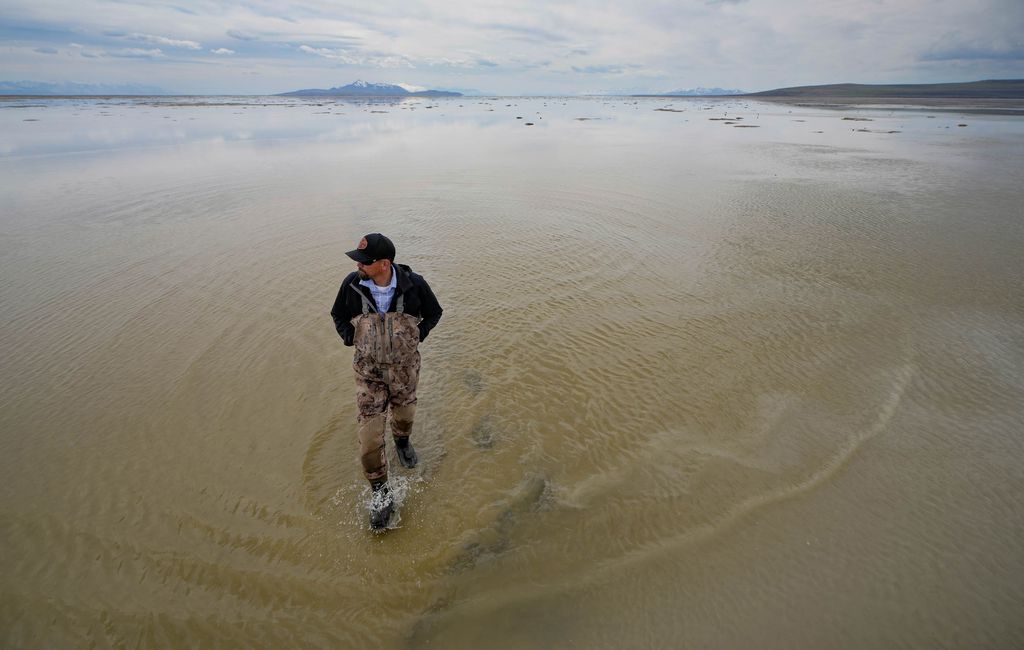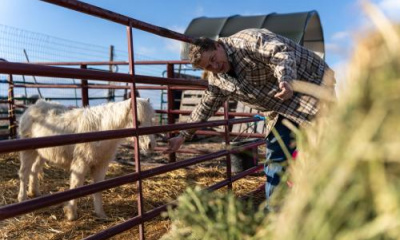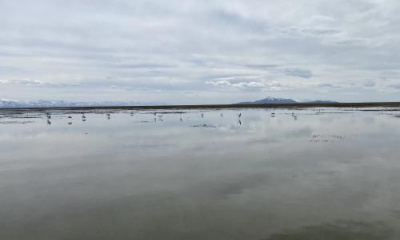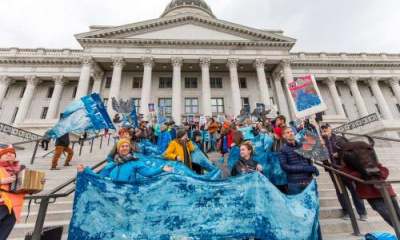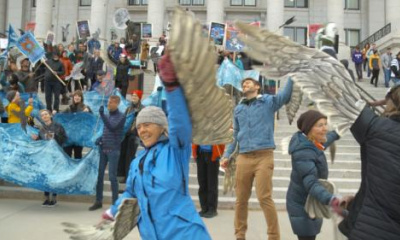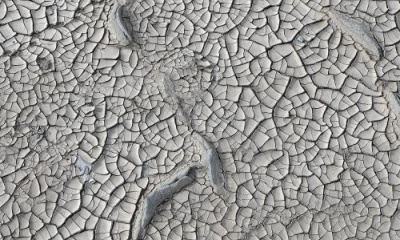New lake coordinator shares thoughts on dust pollution, the role of cows in water shortages and whether it’s time for Utahns to accept living with a smaller lake.
The state’s new czar overseeing all things Great Salt Lake has a lot of work ahead while an environmental time bomb continues to tick.
Last week, Gov. Spencer Cox tapped Brian Steed to fill a new slot as lake commissioner. If confirmed by the Senate, Steed will coordinate the many state agencies overseeing the Great Salt Lake’s water supply, water quality, wildlife and industries, all while preparing a strategic plan on how to keep the lake from shriveling up, and delivering it to lawmakers by November.
That’s no small feat for any state employee, and Steed’s also going to juggle it with his current job as executive director of the Institute for Land, Water and Air at Utah State University. Record-breaking snowpack may have bought Steed a little breathing room — it has already raised the lake’s elevation more than four feet from its record low in November.
Still, Steed acknowledged the immensity of his assignment.
“It’s gonna be a challenge. I’m not gonna lie about that,” he said in an interview Tuesday with members of the Great Salt Lake Collaborative. “But ultimately, I think I’m optimistic that we can make a difference.”
Steed brings a lot of Great Salt Lake experience to the job. He helmed the Utah Department of Natural Resources for three years, which houses many of the divisions overseeing the lake’s health and operations. He also coleads the Great Salt Lake Strike Team, which presented a report earlier this year on possible solutions to save the lake, along with an evaluation of their expense and practicality.
He shared his outlook on his new role, and how he intends to keep the lake from dropping to the brink of collapse once again.
Even after a record-breaking winter, the Great Salt Lake is not in the clear
While Steed remains optimistic that good data and research can help lawmakers form the best policies to keep the lake at a sustainable elevation, he’s realistic about its current situation.
The record-breaking water year has helped, but many of the irrigation practices and other human-caused challenges that nearly crashed the lake’s ecosystem remain in place.
“While yes, we’re all very heartened by the recent year we’ve had,” Steed said, “we still have great cause for concern.”
The lake needs to rise at least five more feet to get to a level where its dust-generating lakebed is covered and can begin to reform a protective crust.
“We will have dry years in the future,” Steed said. “...[And] when it comes to things like dust, we really haven’t covered up what needs to be covered up until we get to higher levels.”
Why aren’t state leaders trying to keep down dust currently blowing off the lake?
Even after an impressive rise in elevation, the Great Salt Lake still has a lot of drying, exposed lakebed that’s continuing to generate windblown dust. Dust is unhealthy on its own, triggering asthma attacks and inflammation. Long term exposure to dust pollution can also cause pulmonary diseases and cancer. The Great Salt Lake’s dust has contaminants like heavy metals and arsenic. The impact it’s having on the health of Wasatch Front residents remains unclear.
California regulators have found effective ways to control dust at Owens Lake, however, like shallow flooding or covering the lakebed with gravel. So why aren’t Utah’s leaders doing the same for hot spots on the Great Salt Lake that are blowing dust?
“People made the policy calculation on Owens Lake that it’s not gonna be a lake again,” Steed said. “I don’t think we’ve made that policy calculation on the Great Salt Lake.”
Pollution control efforts at Owens Lake have been expensive, too. The City of Los Angeles, which dried the lake to dust after siphoning away its tributary water to support a growing population, has shelled out $2.5 billion in mitigation efforts to date.
“We think there’s a more cost-effective method,” Steed said, “and that more cost-effective method is to get more water into the Great Salt Lake, currently.”
Agriculture and water leasing remain big policy levers
Lawmakers overhauled Utah’s old water laws to allow water rights holders to donate or lease what they have to environmental benefits like the Great Salt Lake. So far, only two such agreements have been made. In 2021, Rio Tinto Kennecott announced it would donate 21,000 acre-feet per year over the course of 10 years to benefit the lake. And earlier this year, The Church of Jesus Christ of Latter-day Saints said it would donate a similar amount to the lake in perpetuity.
But the lake has seen shortfalls of more than 1 million acre-feet in recent years (not counting this spring).
“While neither of those (donations) individually is going to save the lake,” Steed said, “they certainly show us the way forward.”
Steed acknowledged the proposition of paying farmers and other water users to dry up their operations in exchange for state money hasn’t exactly been popular so far.
“And for good reasons,” he said. “In some cases, that may have a huge economic cost.”
There have been some limited cases on the Colorado River, however, where a pilot program successfully convinced some irrigators to give up their water.
“The real key,” Steed said, “... is to find out how we can make that work for both the farmers and the lake.”
Is it time to convince Utahns and other U.S. consumers to give up beef?
The elephant in the room as policymakers discuss water shortages in the arid West is cattle. A recent graphic created by The New York Times succinctly shows the problem: More than half of the Colorado River’s water is used to grow feed for livestock. And research from 2020 is more explicit — that water is supporting beef and dairy cows.
In the Great Salt Lake basin, agriculture has consumed 63% of the water that would otherwise flow to the lake. The bulk of that water is also used to grow alfalfa and other hay products consumed by cows.
Utah officials have amped up their messaging on water conservation across the state, even throwing millions at a “Utah Water Ways” project to ensure those messages stick. Asked whether the state should also develop a campaign encouraging Utahns to cut back on beef consumption, Steed hedged.
“In this state, I certainly could eat less beef and be healthier,” he said. “That being said, I’m not sure the state wants to be in the business of telling people what they can or can’t produce that way.”
Should Utahns learn to live with a smaller Great Salt Lake?
The Great Salt Lake Strike Team report Steed helped compile identified a railroad causeway berm bisecting the lake as a viable solution for staving off collapse. The berm has an opening that can be raised or lowered, effectively cutting the lake in two — a hypersaline north arm supporting little life, and a healthier south arm that sustains brine shrimp and brine flies, the two keystone species in the lake’s ecosystem.
State regulators raised the berm multiple times last year as the lake shrunk and its salinity spiked. It’s one of the quickest and most easily deployed tools available to prevent the lake’s demise.
Legislation passed this year authorizes more berms and dikes to keep at least a small portion of the lake ecologically functional. But Steed said policymakers aren’t yet ready to concede to a smaller, engineered system as the Great Salt Lake’s likely future.
There are consequences for a smaller lake, he noted, including all that exposed lakebed.
“For salinity purposes, a smaller lake makes a lot of sense,” Steed said. “For dust purposes, a smaller lake doesn’t get there ... we also have to be concerned about those human impacts.”

